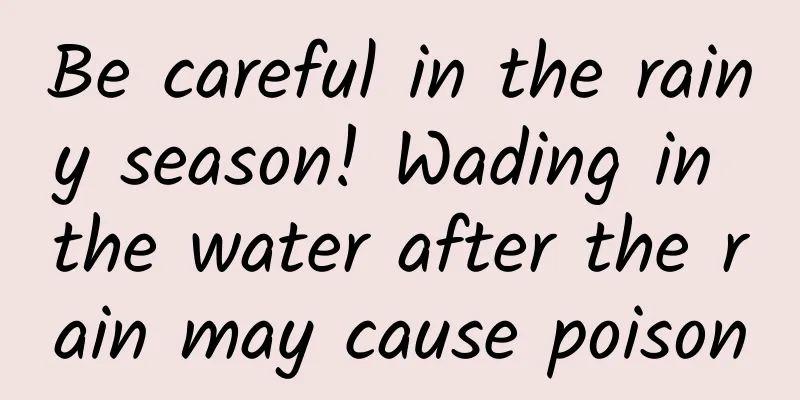Be careful in the rainy season! Wading in the water after the rain may cause poison

|
Guangzhou has been hit by heavy rains since May, and all major news outlets have been telling everyone to avoid wading in water. In addition to the hazards we can see, there is another easily overlooked bacteria that may sneak up on us, and that is Clostridium perfringens. What is Clostridium perfringens? How come I have never heard of it? In fact, it is widely present in the soil and the intestines of humans and animals. It is not only one of the most common pathogens of gastrointestinal diseases in humans and animals, but also an important pathogen that causes human infections. It is a Gram-positive, thick rod with slightly blunt ends. The spores are oval, slightly smaller in diameter than the bacteria, and located at the second extreme, but spores are rarely observed in tissues or in vitro cultures. It cannot move. It is anaerobic, but not strictly so. The bacteria has a very active metabolism and can decompose many common sugars, produce acid and gas. In the milk culture medium, it can decompose lactose to produce acid, causing the casein in it to coagulate; at the same time, it produces a large amount of gas (H2 and CO2), which can flush the coagulated casein into a honeycomb shape, push up the vaseline layer sealing the liquid surface, and even flush away the cotton plug at the mouth of the test tube. The momentum is fierce, which is called the "turbulent fermentation" phenomenon. It is divided into five serotypes. Type A is widely found in nature, such as soil, sewage, and the intestines of humans and animals. The main pathogenicity to humans is type A. Why is it so powerful that it can cause illness in people? The important pathogenic substances in its type A are α-toxin and enterotoxin. α-toxin can decompose the complex formed by phospholipids and proteins on the cell membrane, causing lysis of red blood cells, white blood cells, platelets and endothelial cells, causing hemolysis, increased vascular permeability with bleeding, tissue necrosis, liver toxicity and impaired myocardial function, and plays a major role in the formation of gas gangrene. Enterotoxin: Mainly produced by type A strains, it is a heat-insensitive protein that is instantly destroyed at 100°C, and its toxicity can be enhanced by the action of trypsin. After enterotoxin binds to the receptors on the brush border of ileal and jejunal epithelial cells, the entire enterotoxin peptide chain is embedded in the cell membrane, changing the permeability of the cell membrane, leading to the loss of intracellular fluid and ions, and causing diarrhea. Enterotoxin can also act as a superantigen to activate T lymphocytes and release various cytokines, participating in pathogenic effects. What diseases does Clostridium perfringens cause? (1) Gas gangrene: 60%-80% of cases are caused by type A. However, in addition to Clostridium perfringens, at least five other Clostridium species can also cause gas gangrene. The disease is more common in war injuries and earthquake disasters, and can also be seen in large-area trauma caused by industrial injuries, car accidents, etc. The pathogenic conditions are similar to those of Clostridium tetani. (2) Food poisoning: It is mainly caused by ingestion of large amounts (10°~10″) of food (mainly meat products) contaminated with enterotoxin-producing type A bacteria. It is more common. The incubation period is as short as about 10 hours. The clinical manifestations are abdominal pain, bloating and watery diarrhea; no fever, nausea and vomiting. It heals itself after 1~2 days. If bacteriological examination is not performed, it is often difficult to confirm the diagnosis. (3) Necrotic enteritis: caused by food contaminated by type C bacteria, affecting the jejunum. Clinical manifestations include acute abdominal pain, vomiting, bloody diarrhea, intestinal wall ulcers, and even perforation leading to peritonitis and shock. So how to treat and prevent it? For local infection, surgical debridement should be performed as soon as possible to remove infected and necrotic tissues, and amputation should be performed if necessary to prevent the spread of the lesion. Use large doses of antibiotics such as penicillin to kill pathogens and other bacteria. If conditions permit, gas gangrene polyvalent antitoxin treatment and hyperbaric oxygen chamber therapy can be used, the latter of which can increase the oxygen content in the blood and tissues by 15 times and partially inhibit the growth of anaerobic bacteria. There is no vaccine for prevention. It can be seen that after a heavy rain, the water becomes deep and it is very easy to have invisible small debris. If the skin is scratched and the broken skin is exposed to the rain full of bacteria, it will give them an opportunity to take advantage of the situation. Only by understanding the habits of microorganisms can we prevent them. References for this article: Medical Microbiology, 9th edition |
Recommend
Which came first, the chicken or the egg? Maybe the dinosaur egg came first!
There is a legendary "dark cuisine". So...
How do mini program development companies and mini program agents make profits?
How do mini program development companies and min...
Ten tips to speed up Android app building
The build speed of the application will directly ...
The garlic I ate yesterday still smells today! I heard that drinking yogurt can get rid of the garlic smell immediately?
As the saying goes, "If you eat meat without...
I studied Android JNI, but there are a few points I don't understand
[[437215]] This article is reprinted from the WeC...
App Store Redesign: All the Changes to the App Store in iOS 11
After WWDC17 ended, many people focused their att...
Rules and features of Facebook advertising in 2019!
In the social media industry, “speed is everythin...
I don't have to worry about breast cancer because no one in my family has had it? Is breast cancer a terminal illness? The truth is...
With the improvement of living standards and heal...
Holding urine until you urinate blood, you don’t know enough about the harm of holding urine...
People lined up at 3 a.m. to buy internet celebri...
How to deeply interpret those operational professional terms?
"After launching this activity, the daily UV...
E-paper, naked-eye 3D display...what will the future display look like?
Produced by: Science Popularization China Author:...
Children play with mobile phones for a long time? Research warns: brain is immature and self-regulation ability is poor
The 7-day Spring Festival holiday has ended. I be...
Three or four times a night, accidentally becoming a "night owl"? Experts: No more than this number is normal
How many times a night do you do this? When I was...
6000 words to build a million private domain system!
At the beginning of the article, let us first cla...
Tips on how to get an operational plan with millions of PVs!
There are two types of information platforms on t...









